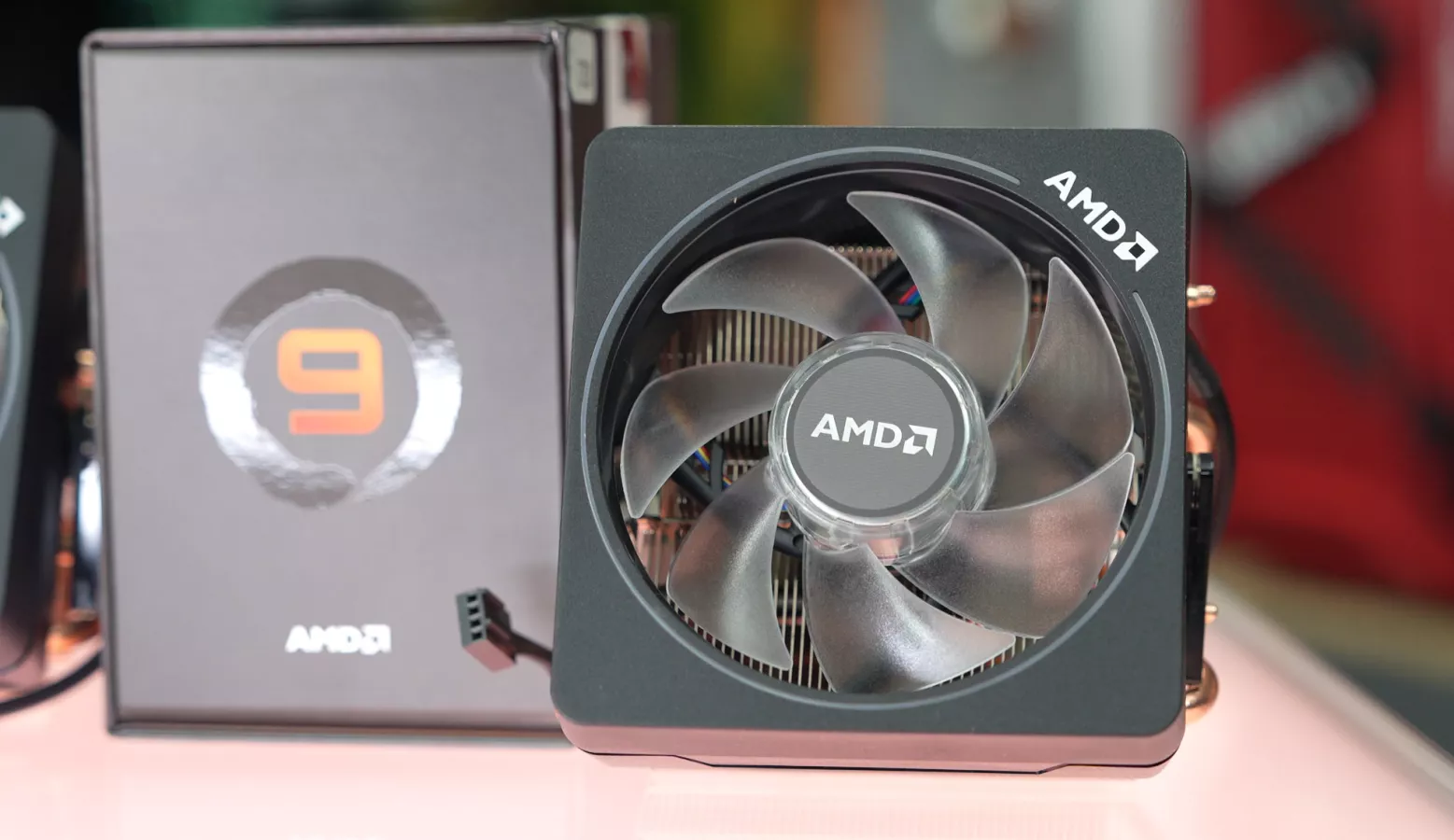AMD's Ryzen 7000 CPU lineup. Despite a lower price, AMD still has nothing competing in the sub-$200 class.
We already covered the background for this wave of non-X Zen 4 CPUs in our R5 7600 review, so if you haven’t seen it, go back and watch the beginning of that one.
The R9 7900 is a 12-core CPU from AMD using the Zen 4 architecture for $430. That positions it in direct competition with the 13700K. It’s basically the same as the 7900X, except it has AMD’s 65W TDP applied. That means it’s limited to 88W of socket power out of the box, which is actually pretty conservative for a 12-core in some situations. You can however apply Precision Boost Overdrive (PBO), to remove that limit – sort of the inverse to Eco mode on the X parts.
Let’s explore that thermal & power behavior first.
Power, Mechanical, & Thermals
Thermals
Let’s break up the performance charts by looking at thermal behavior. This was a big talking point during the original Ryzen 7000 launch as the higher core count parts ran right up against AMD’s thermal limit of around 95C during any kind of intensive load.

When we look at the 7900X’s line in red, we see the quick rise and steady hold at 90C. For the entire duration of the test it never falls, as the Zen 4’s boosting algorithm is holding it there.
When you run one that’s limited to AMD’s 88W PPT, the 7900 non-X only rises to the low 40C range – nearly 50C below the original. This thing is massively easier to cool due to the power limit. The cost is absolute performance, but just like with Eco mode on the X, you have the choice. It’s just that with the 7900 you get to pay less.
Power Consumption - nT Blender
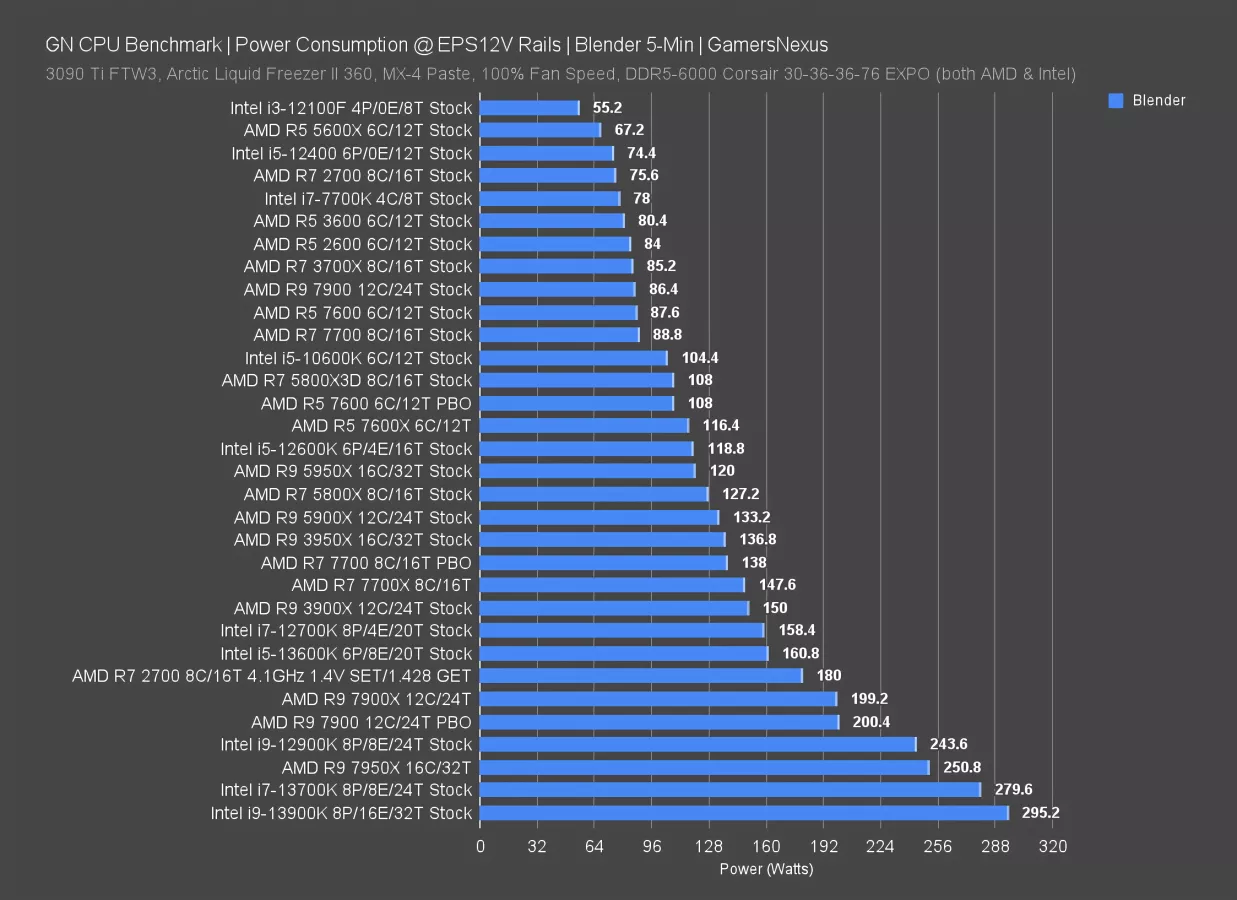
People who want the most output and care less about the efficiency could still benefit from a 7900 rather than a 7900x, as nothing much changes aside from the price.
We’ll look at power consumption at the EPS12V cables now: In this, the R9 7900 ran at 86.4W, or about the same as the R5 7600 and R7 7700. That should make it far more efficient than the 7600. Enabling PBO blasted the power and pushed it up to 200W, nearly identical to our 7900X result at 199W. That’s a big swing, so even when the gains are more noteworthy, they do come at the cost of power. This just means that people who want the most output and care less about the efficiency could still benefit from a 7900 rather than a 7900x, as nothing much changes aside from the price.
The Intel i7-13700K competitor pulls 280W in the same all-core workload. Now, in gaming, that’ll fluctuate more and be more variable; but for purposes of all-core tests, AMD is far more efficient here.
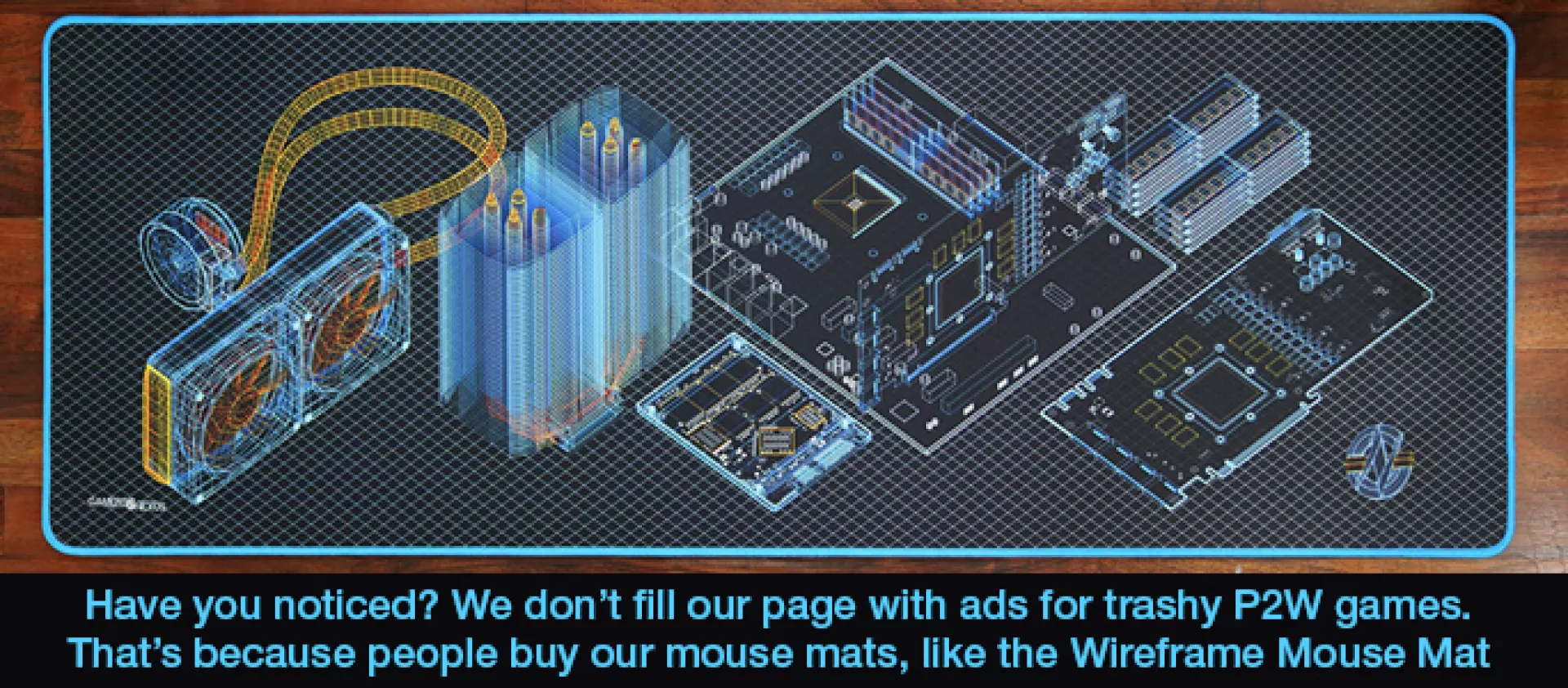
Performance Per Watt Efficiency
Power efficiency is next, giving us a composite look at energy consumption during the course of a test. In other words, it’s all about how much total energy do we burn to complete the same amount of work, even with time as a variable.
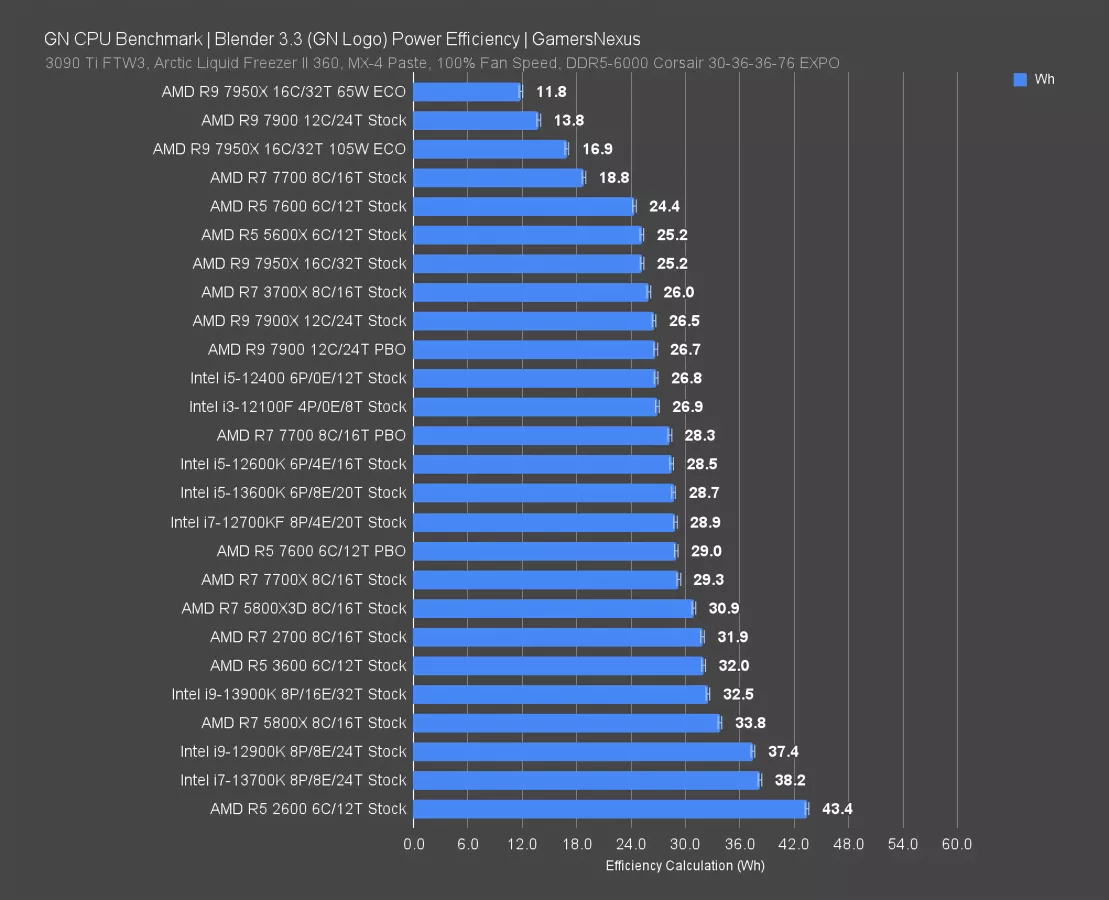
The R9 7900 stock CPU plotted at 26.7Wh with PBO, 26.5 -- so the same -- with the X strapped to the end, and an impressive 13.8Wh out of the box. Even though it’s finishing the work slower, it’s doing so in an impressively efficient way. Only the 7950X at 65W beats it, and we already remarked that running a 7950X at 65W is generally a waste of its power -- the 105W eco mode is a far better balance.
The competing 13700K at 38Wh is significantly less efficient than these options.
Production & Workstation Benchmarks
The next round of testing is for production and workstation applications, so non-gaming workloads that are commonly used in daily work or hobbies. These tests include CPU benchmarks for video editing, rendering, photo editing (Photoshop), 3D animation and rendering, code compile, and more.
Blender
Blender Cycles rendering is up first, where we run a tile-based render that loads each thread individually. This is done with a custom in-house made render that helps tax the CPUs in a fair and comparable, but realistic way.
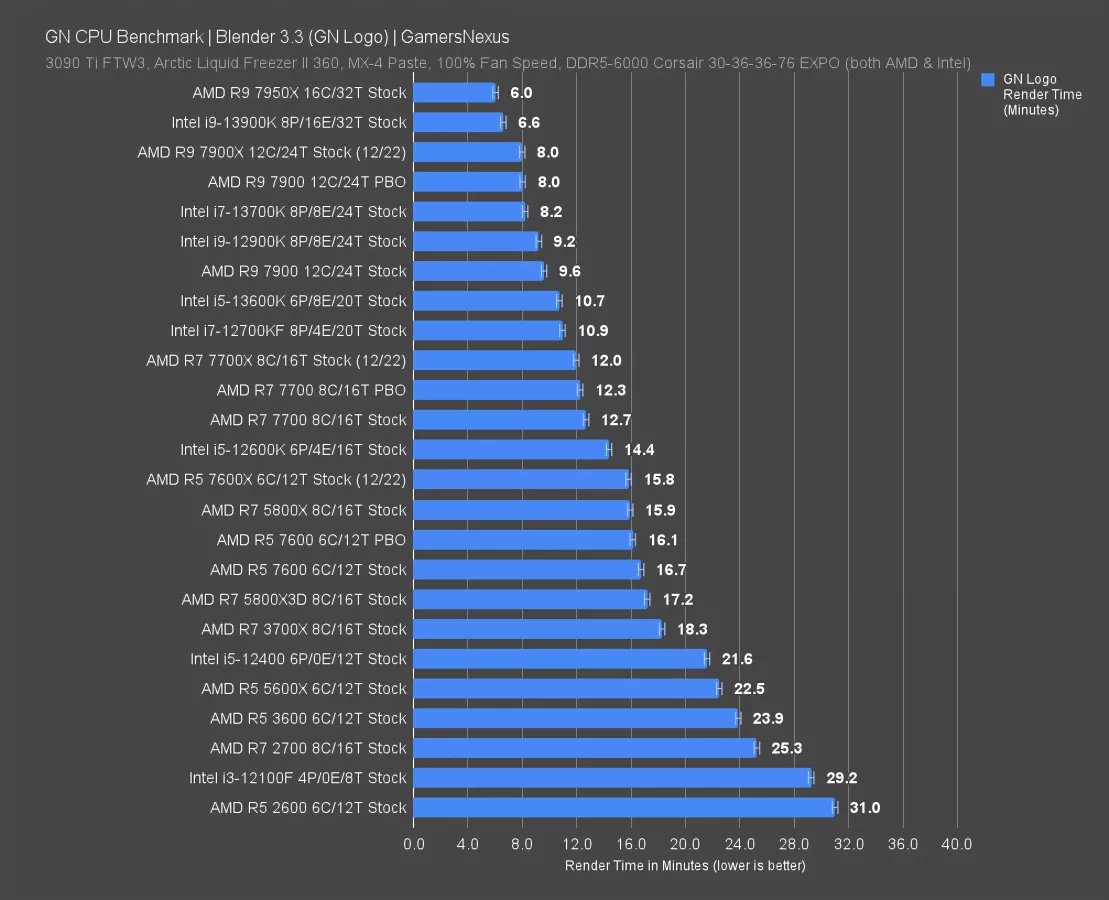
The chart positions the R9 7900 at 9.6 minutes to complete the render, with PBO posting an impressive reduction to 8 minutes -- the exact same as our 7900X result. That means that the 7900X and 7900 with PBO require 17% less time to render than the 7900 stock CPU, clearly illustrating that, to save some money, you should just buy the 7900 and then enable PBO. It’s easy.
Moving to the i7-13700K competition, Intel’s 8.2-minute result is better than the stock 7900 (by a noteworthy 15%), but just behind the PBO and X-SKU results. This is a far closer match than the 7700 vs. 13600K that we just looked at.
Chromium
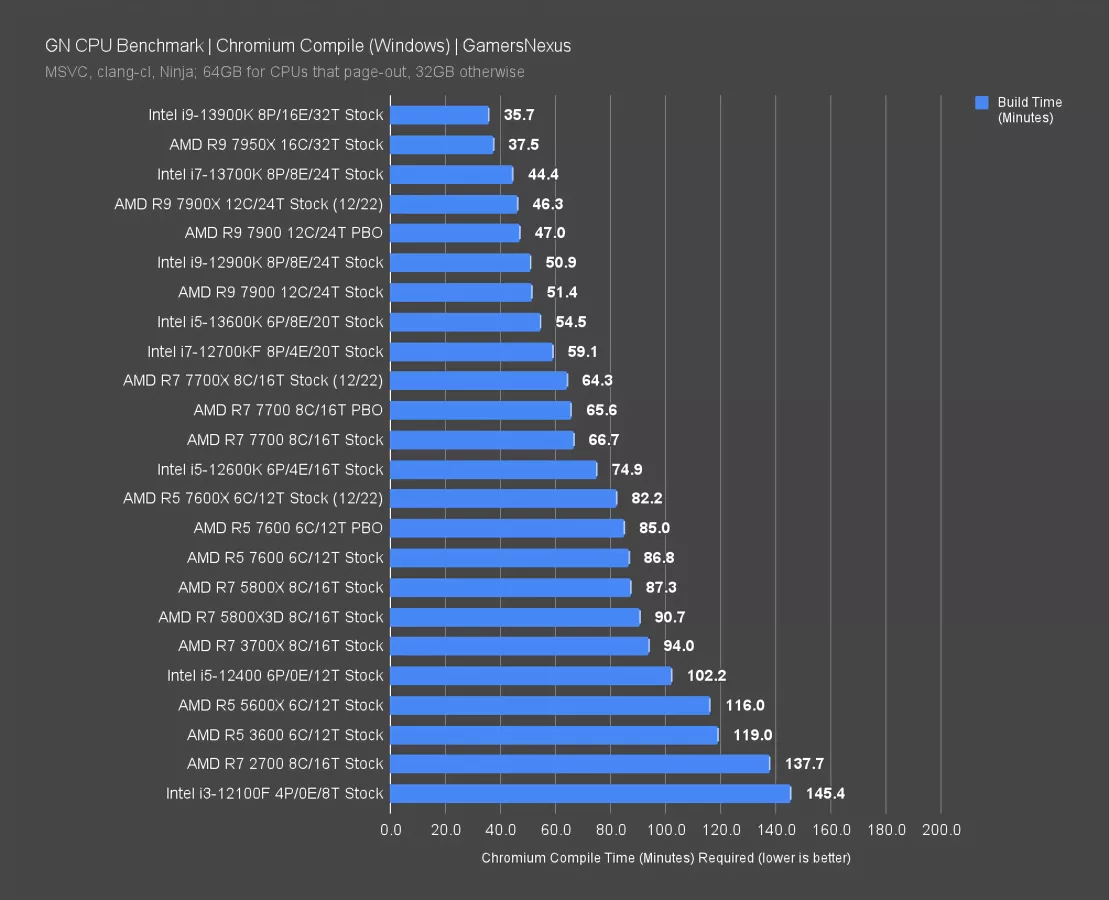
Chromium code compile is up now, giving us a glimpse at performance when working with large codebases.
The R9 7900 stock CPU completed the compile in 51 minutes, positioning it as faster than the 13600K, but slower than the 13700K. Enabling PBO helps, cutting its compile time by 9% and roughly equating the 7900X’s result -- it’s within error, at least.
The 13700K’s 44-minute result has it 4% ahead of the 7900X, similar ahead of the 7900 PBO, and 14% ahead of the 7900 stock.
7-ZIP Compression
Next, we’re testing compression as measured in millions of instructions per second. A higher result means that compression work will complete faster.
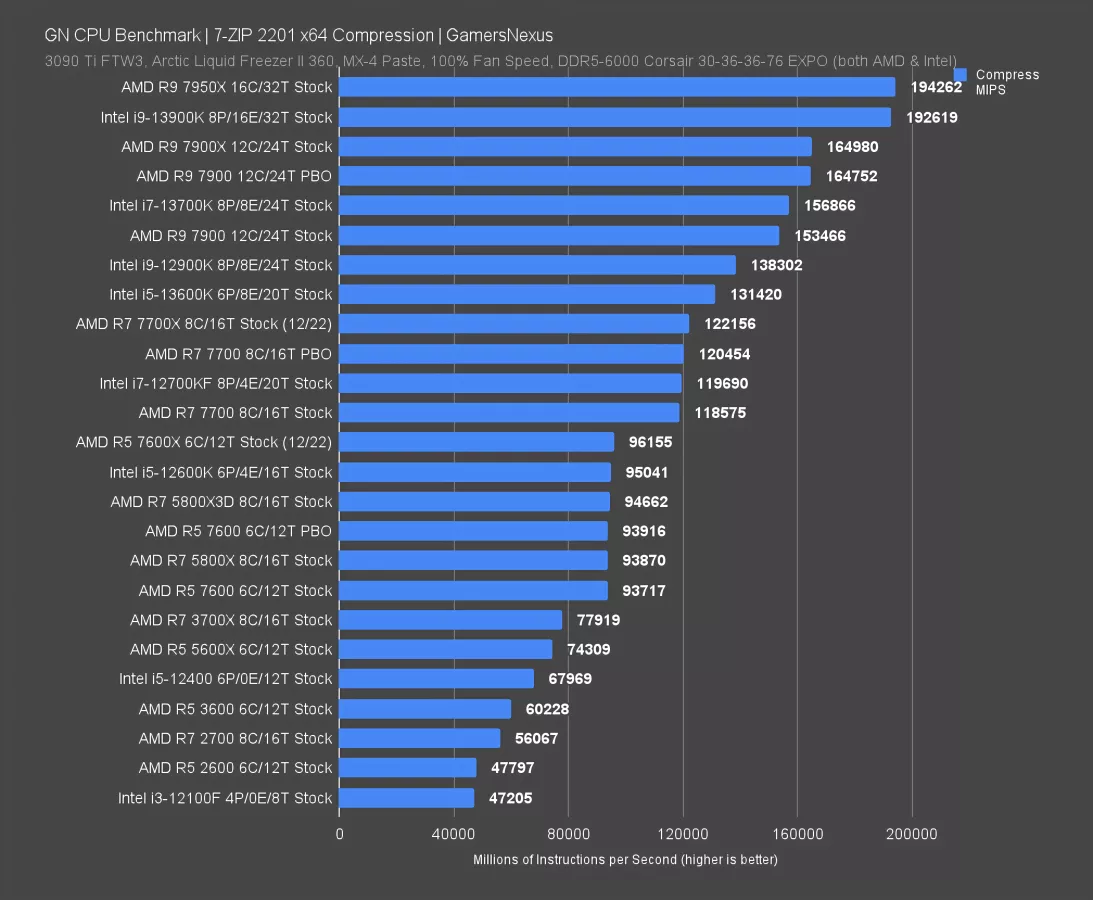
AMD has typically done well with its R9 CPUs in this test. The R9 7900 non-X CPU scored 153K MIPS, and enabling PBO actually does something in this one -- finally. The PBO’d 7900 jumps 7.4%, more than we saw with most other tests. That puts it next to the 7900X and its 165K result, where the two are within run-to-run variance and functionally equal. Compared to the R7 7700 stock result, that’s an uplift of 29%.
But the true competitor isn’t the cheaper 7700 -- it’s Intel. The i7-13700K, currently a similar price, completed 157K MIPS. That has it behind the 7900 and 7900X by more than just error -- allowing the two a lead of 5%. Technically, it’s ahead of the 7900 stock, so the 13700K just lands between all the R9 7900 results. We’ll need other tests to really make a judgment.
7-ZIP Decompression
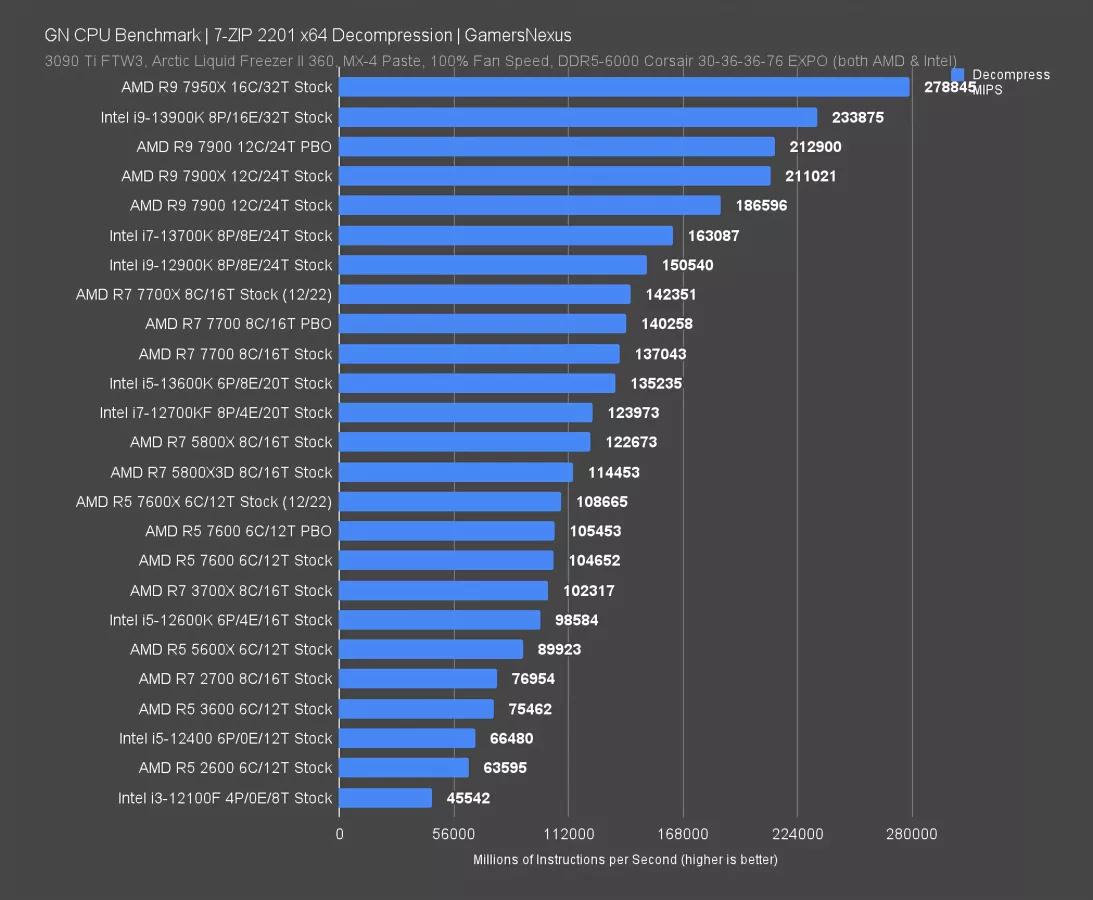
The charts get shaken-up in decompression testing: The AMD 7900X and 7900 PBO are the same and are within error. That’s why the PBO result is technically ahead. They’re within variance. The 7900 is still outside of error, allowing the PBO result a relatively massive gain of 14%. That’s a lot more than we’ve seen in the prior reviews.
The Intel competition’s 163K result leaves a lot to be desired. AMD is the victor in this one; while it looked weak at the 7700 level versus the 13600K, it may have better footing in the R9 7900 class.
Adobe Premiere
Adobe Premiere is what makes our world go round, despite sometimes rendering more crash reports than frames. This test looks at video editing and playback performance.
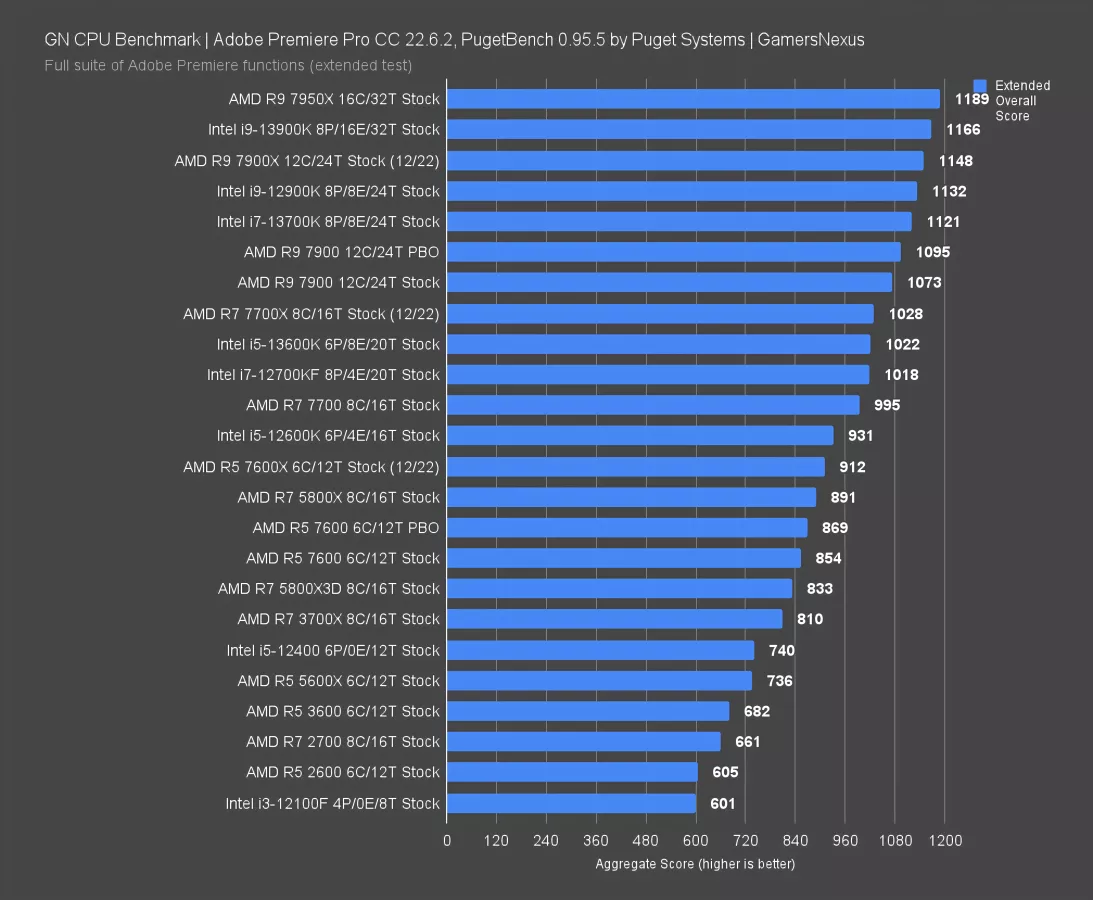
The R9 7900 stock CPU scored 1073 points in aggregate between filters and FX, renders, and playback. Enabling PBO got us to 1095 points -- so no meaningful change. The 7900X ran ahead of both, at 1148, or 7% ahead of the 7900 stock. The 13700K isn’t advantaged here like it is in some other tests, so this has been a cleaner back-and-forth between it and the 7900. It’s just between them.
Adobe Photoshop
Adobe Photoshop is our last production benchmark before we get into some gaming tests. This one looks at filters, saves, warps, transforms, and effects.

The Photoshop results had the R9 7900 stock CPU at 1501 points in aggregate, which ties it with the 13600K. That’s not a great start. The 7950X stock CPU has always struggled in this test: It’s just not benefited here, at least with our test platform and methods, by its extra cores. Photoshop has other preferences. The 7900 PBO result didn’t change much, but did equate the 7900X. The 7700X does well here and for reasons that we explained in our original X-series CPU reviews, so we’ll leave that discussion over there.
But not as well as Intel: The i7-13700K leads the 7900 stock result by 9% and the PBO boost by 7.8%.
Gaming Benchmarks
This section looks at gaming performance on the CPUs under test. We're evaluating in a (mostly) CPU-constrained set of scenarios, except where otherwise noted with a GPU limitation. This means that the framerates are high, because we're more interested in comparing relative FPS swings than the absolute result.

Shadow of the Tomb Raider - 1080p - 3090 Ti
This CPU isn’t targeted at the gaming-only market, but if you mix gaming and production it should hold its own. Let’s see how it does in our first test, Shadow of the Tomb Raider at 1080p.

There’s not a lot to discuss here – even at 1080p the GPU constrains the difference between the CPUs in the top half of the chart. The 7900 runs within error of itself with PBO applied, and also with the 7900X. The 5800X3D takes the leading position, running 6% faster than the 7900.
These results are with the 3090 Ti, so we re-ran it with the RTX 4090 instead.
Shadow of the Tomb Raider - 1080p - 4090
With the 4090 in the test bench, the data is more interesting. Now the 7900X and the 7900 PBO results are 7% faster than the stock 7900, both running at 284FPS AVG. What’s happening here is that the 7900 at stock is hitting the 88W PPT limit out of the box. The X version has a higher stock limit, and applying PBO to the non-X effectively removes the limit entirely. Normally games don’t cause CPUs to hit power limits like this, but like we saw in the production benchmarks, 12 cores can certainly demand more than 88W.
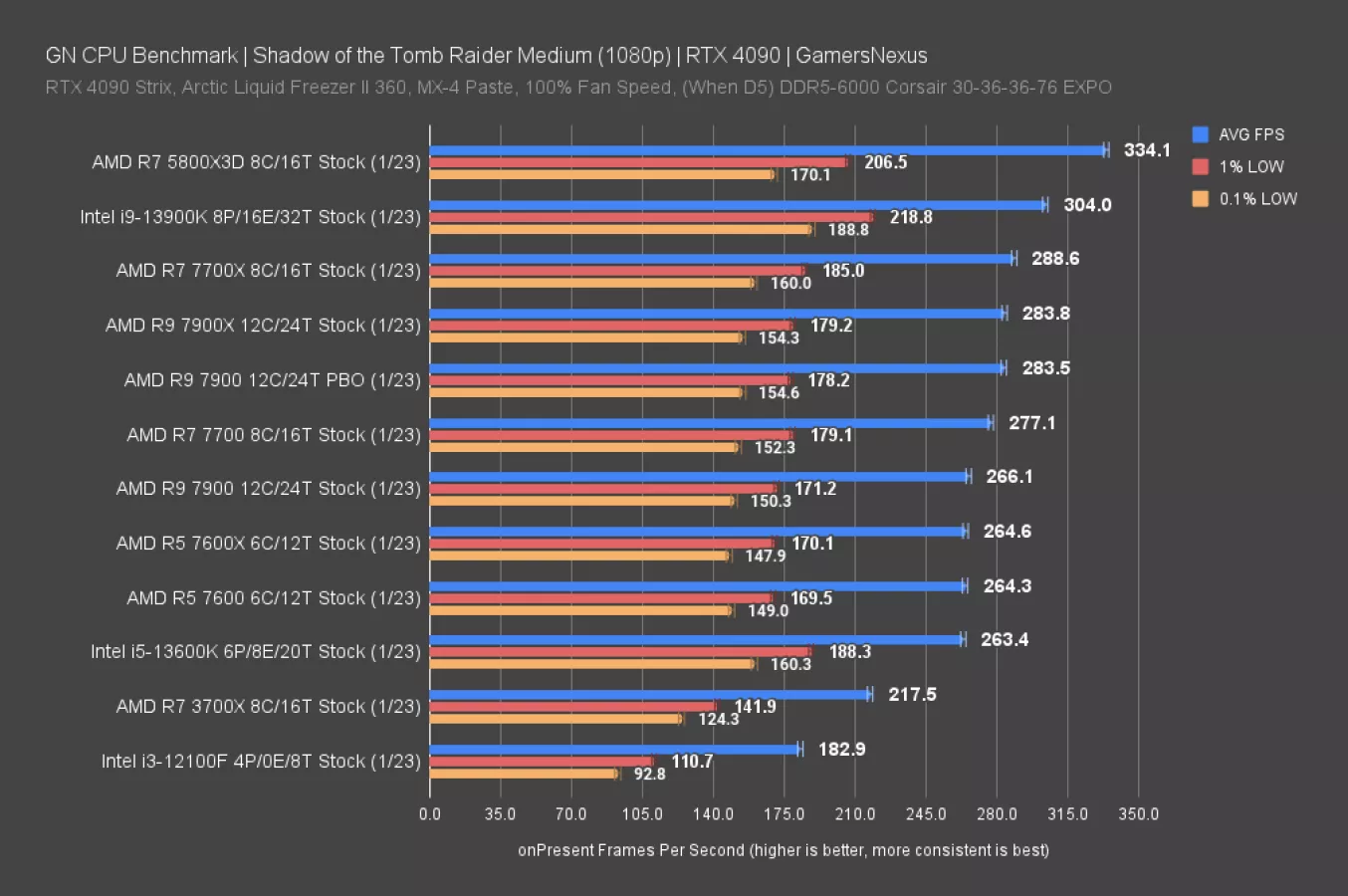
This means that the 7900 is a better value than the 7900X here. However, when we look at the whole picture, the 7600 is clearly where Ryzen 7000 gives best value for this game if you don’t do production work with the same machine.
We see the 13900K pull ahead of the 7900 by 14%, and the 5800X3D really stretching its legs with an impressive 10% lead over that. In the situations where AMD’s 3D V-Cache offers more benefit than raw core performance, it really shines.
Cyberpunk 2077 - 1080p - 4090
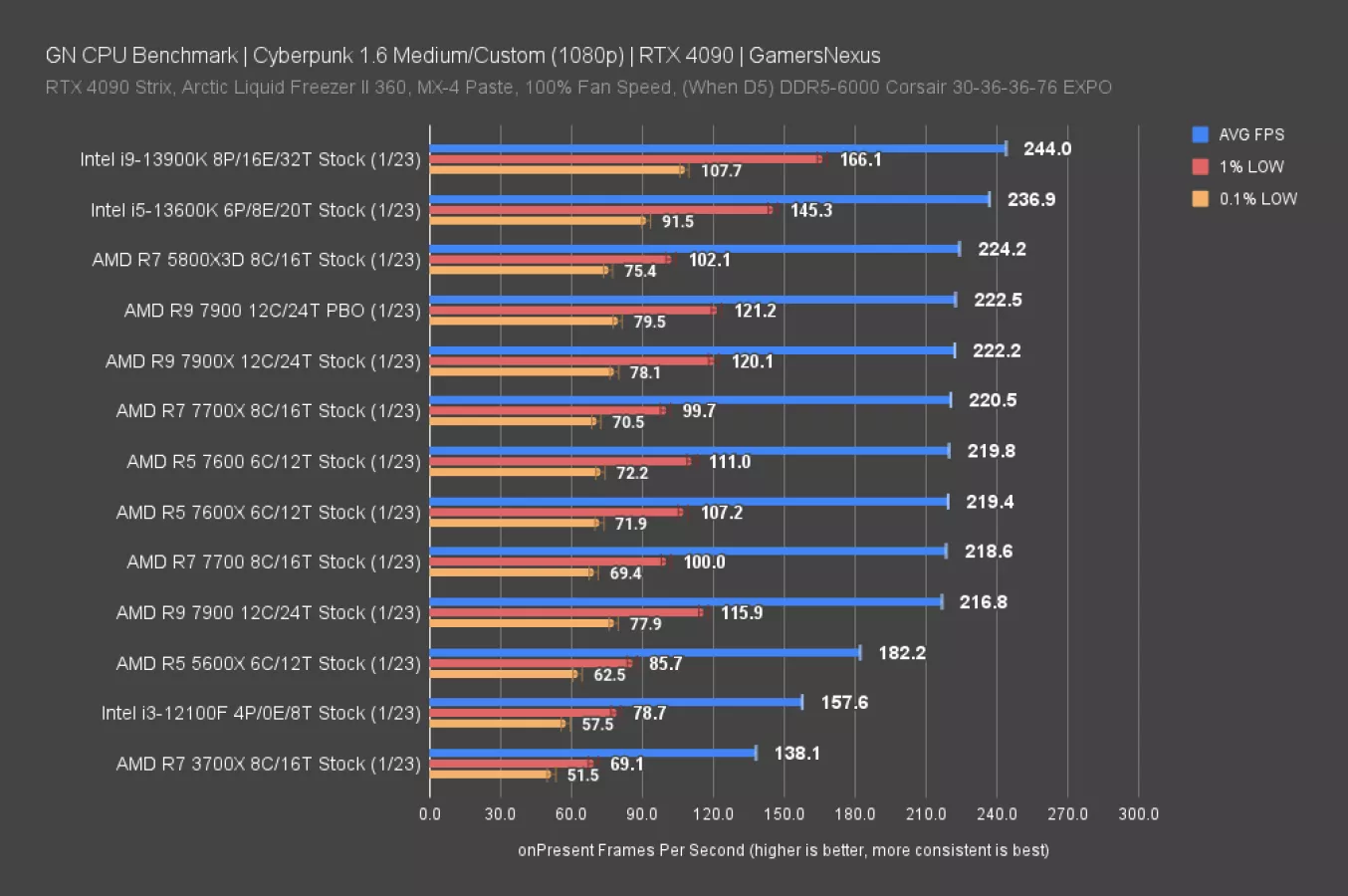
Cyberpunk 2077 is another test where the 7900 ran against the power limit. With PBO applied the 7900 gained 3% over stock, running at 223FPS AVG. That’s a really marginal gain and only significant compared to the rest of the game tests.
That said, the 13600K was able to beat out even the 7900 with PBO applied by 6%. As a reminder, that CPU is about $100 less expensive.
Far Cry 6 - 1080p
Moving on to Far Cry 6 at 1080p, the 7900 lands on the chart at 167FPS AVG, which is tied with the 7700X and falls within error of the 7900X. If you’ve been watching all of these reviews, that won’t come as a surprise to you. Unlike in production or the earlier game tests, PBO doesn’t affect any change here. That’s consistent with results we saw in the 7700 and 7600 reviews as well. Most games just don’t push the CPU hard enough to make it cap on power.
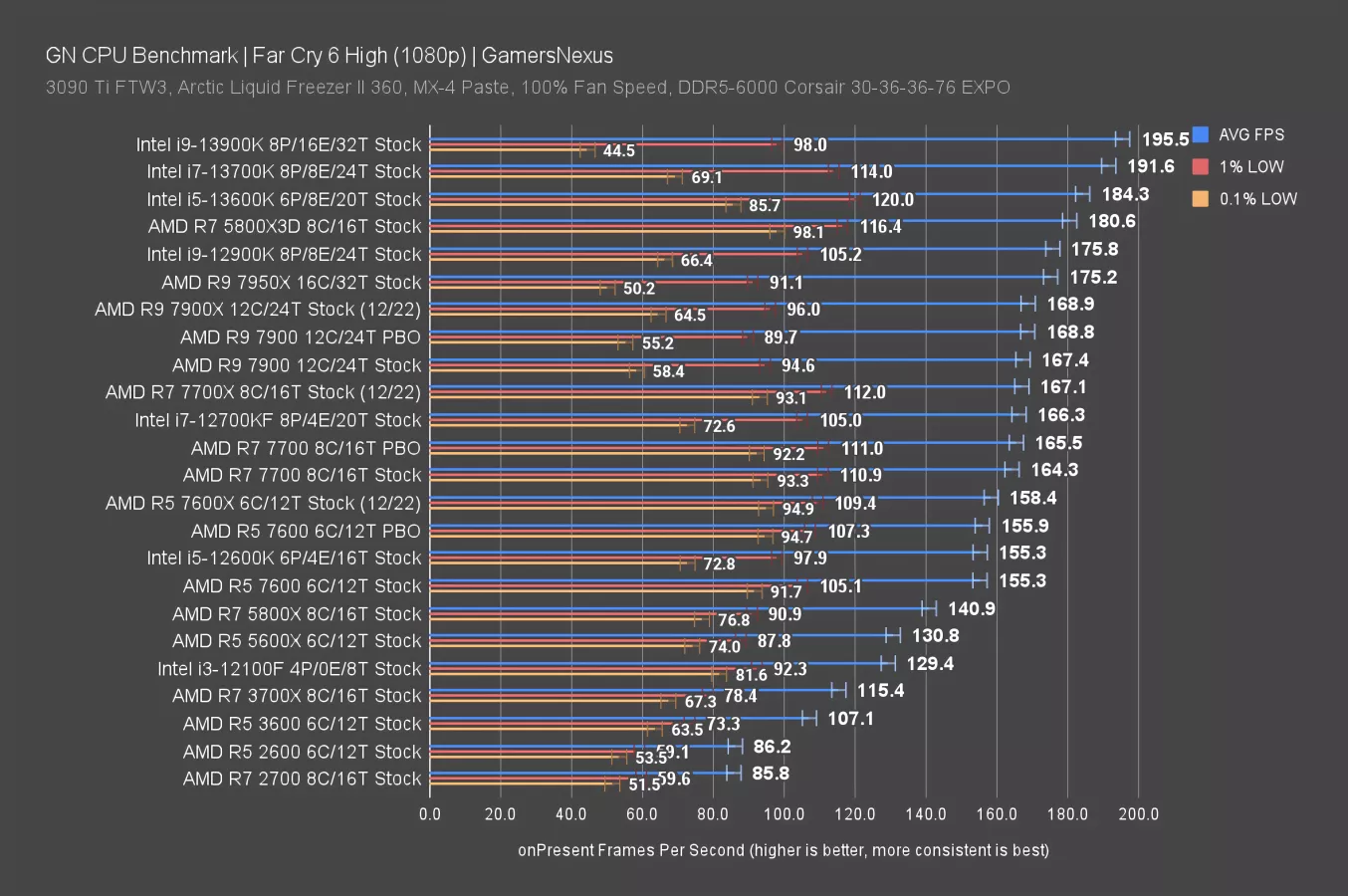
Far Cry is another game that really likes cache, and that’s evidenced by the 5800X3D taking the top spot for AMD and performing 14% better than the 7900.
Compared to the closest-price Intel competition, the 7900 allows a 14% lead to the 13700K, which itself is within variance of the 13900K and represents a better value at this price point. The tight positioning of the 13700K to the 13900K continues throughout our game suite, so we’ll drop the i7 for most of the remaining charts.
Rainbow Six Siege - 1080p - 3090 Ti
Next up is Rainbow Six Siege at 1080p.
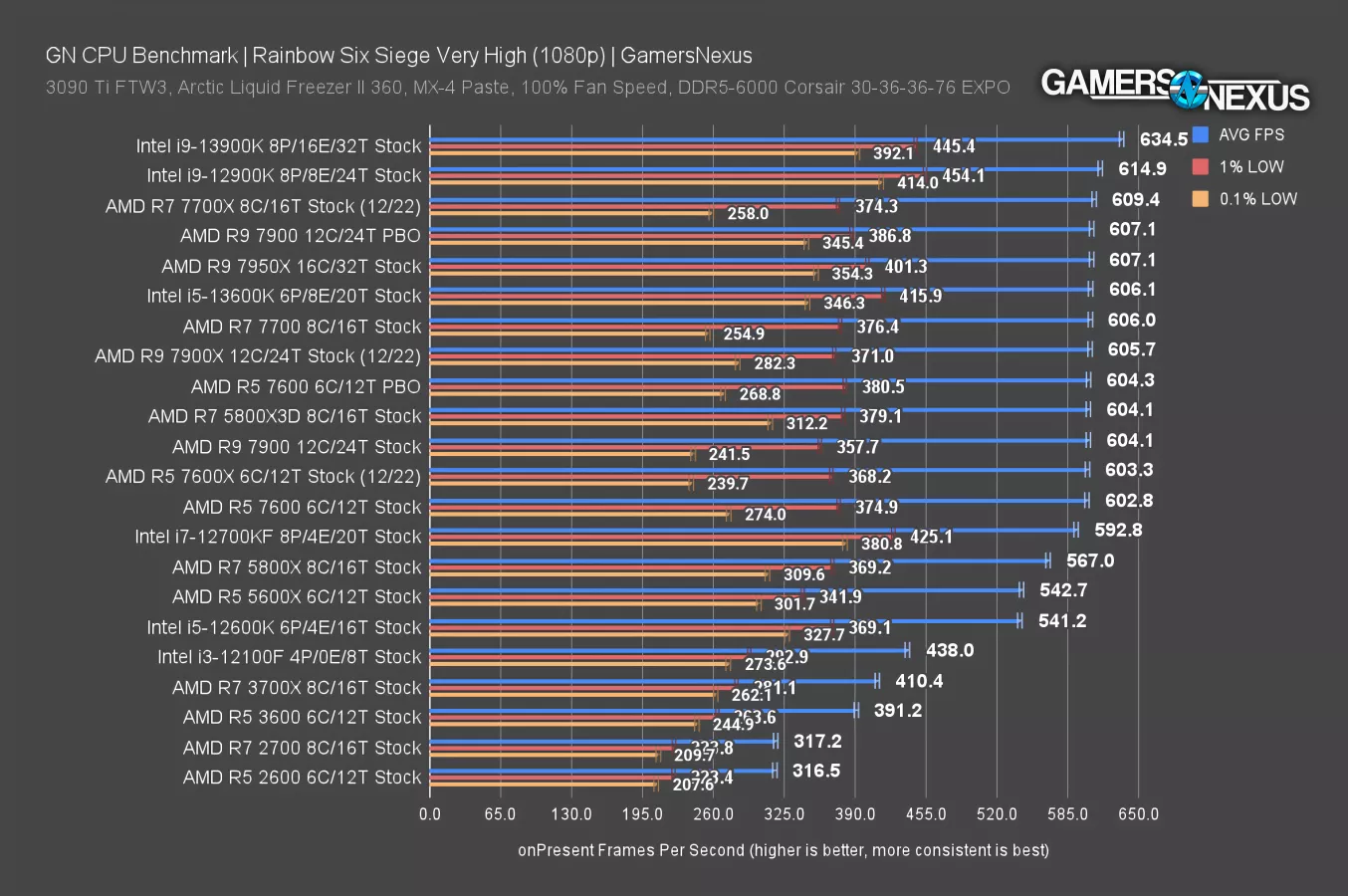
Even though the test isn’t technically GPU bound, the results are compressed enough to make it hard to distinguish between a pretty wide swath of parts. The 7900 is tied with all of the other Ryzen 7000 parts and the 5800X3D at just over 600FPS AVG. The 13900K is the fastest on the chart at 5% over the 7900.
We retested using the RTX 4090 to see if we could spread the results out a little bit, so let’s look at that next.
Rainbow Six Siege - 1080p - 4090
With the 4090, we’ve clearly established that this game isn’t engine bound and we’ve broken the 800FPS barrier -- finally, our framerate is high enough to go pro. That’s all we were waiting on before forming a GN team.
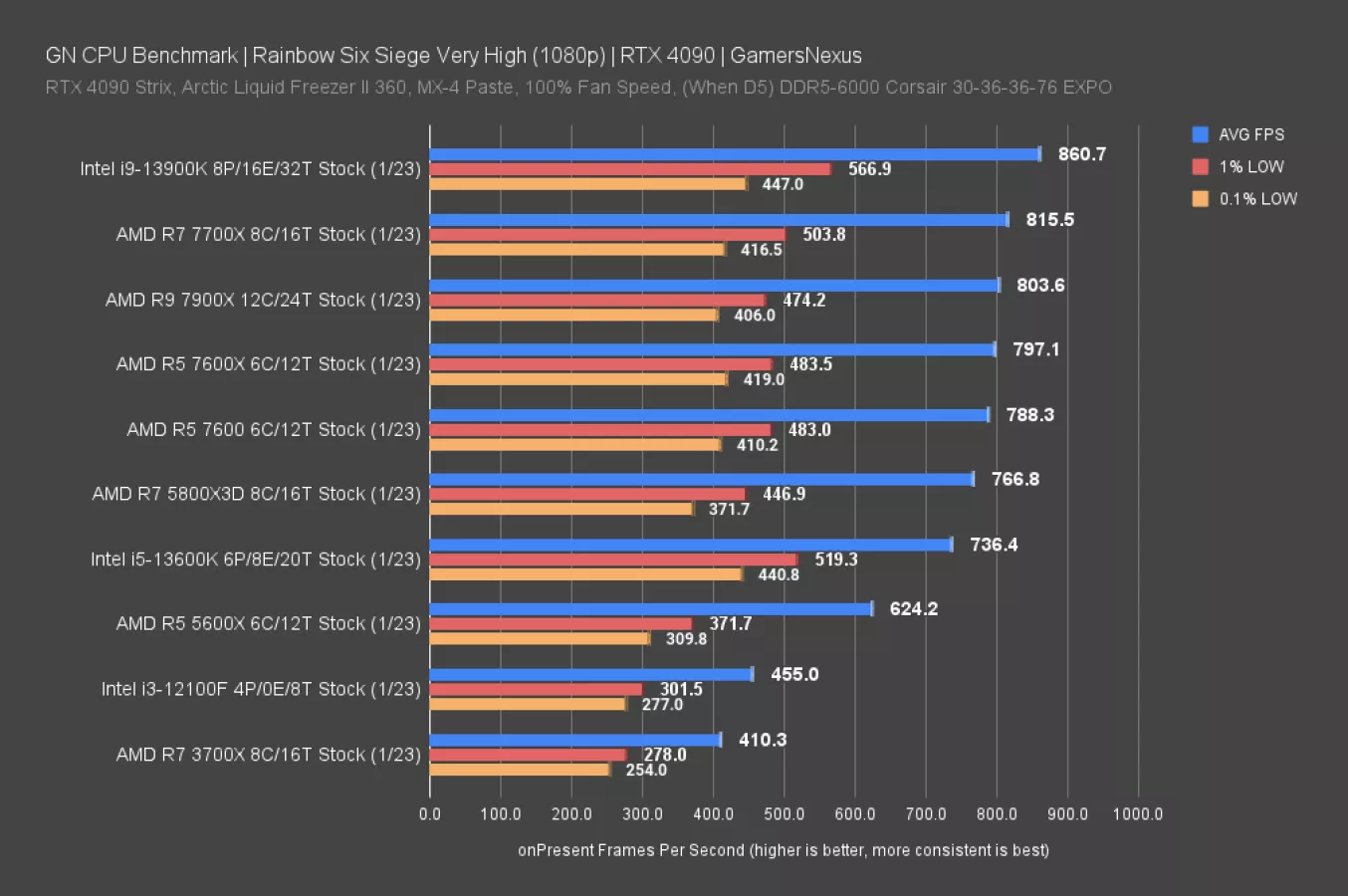
Because of this change, we now have a little more resolution between CPUs. The 7900 is able to push out 798FPS AVG, but still functionally ties with the 7900X and 7600. Compared to the 5800X3D, the 7900 gives 4% more performance.
This increased GPU horsepower also lets the 7700X separate itself from the other 7000 series CPUs very narrowly, with a 2% uplift over the 7900. We only point that out to show that some games prefer the single CCD 6 and 8 core Ryzens over the dual CCD 12 and 16 core models.
Last but not least, the 13900K pushes to 860.7FPS AVG – a record number for any of our benchmarks – for an 8% lead over the 7900. We look forward to breaking 1 KiloFPS in the future.
F1 2022 - 1080p - 4090
Taking a look at the F1 2022 chart with the 4090, we see some scaling.

Now the 7900 falls just on the edge of error with the 7600 by way of a 2% lead. Another interesting thing here is the 7900’s 8% margin over the 13600K; we re-checked this to make sure the behavior was repeatable, and it is.
Overall, everything on the chart runs F1 well, with even the quad-core 12100F holding down an impressive 267FPS AVG.
FFXIV Endwalker - 1080p
Moving on to Final Fantasy XIV at 1080p and back on the 3090 Ti, the 7900 is again tied with the 7900X and PBO results.

It doesn’t do quite as well relative to the single CCD Zen 4 CPUs, like the 7700X that holds an 8% advantage. We wouldn’t necessarily recommend the 7700X though, as Intel’s cheaper 13600K is much more compelling, running 11% faster than it. The 13900K runs away with this one, blowing the 7900 out of the water by 37%.
Total War: Warhammer 3 - 1080p - 4090
Finally we have Total Warhammer 3 at 1080p on the 4090.
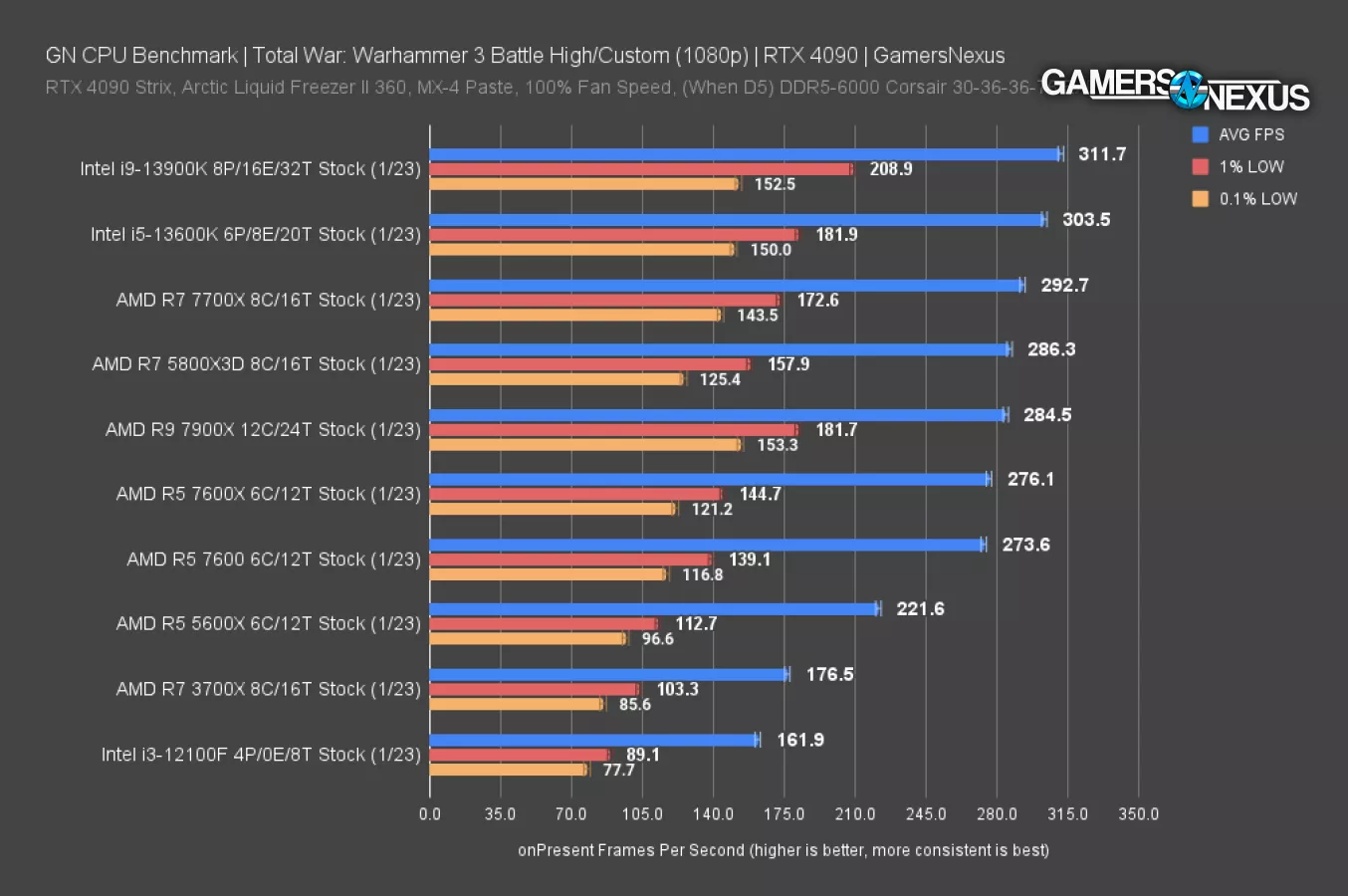
The 7900 lands on the chart at 282FPS AVG. Neither the PBO results nor the 7900X move the needle significantly, in line with what we’ve found to be typical for these non-X parts. The 7700 offers somewhat better performance and value, but the real pick here is the 13600K – it’s got 8% over the 7900 for about $100 less.
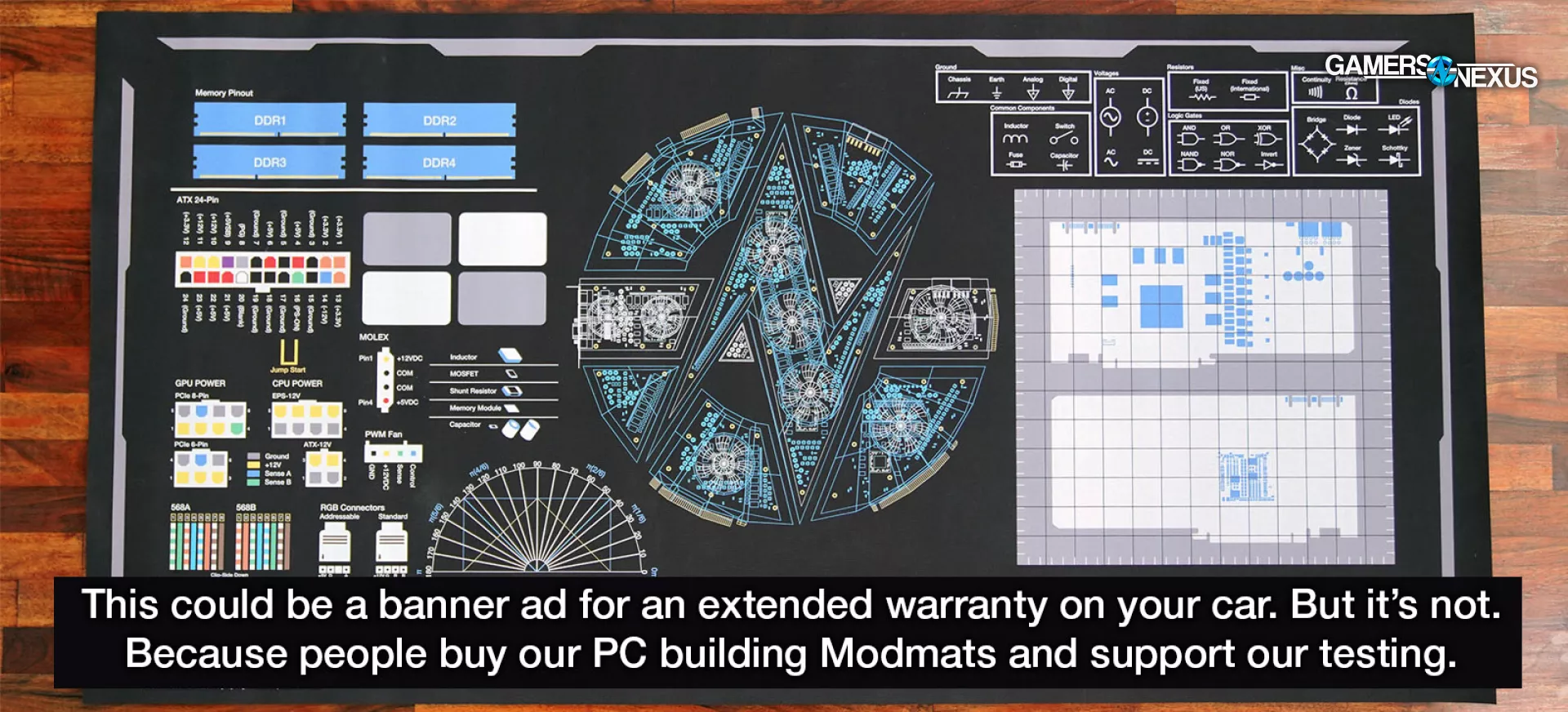
Conclusion
At stock, power and thermals are obviously way down versus the 7900X or 13700K, but PBO puts it right back up to 200W. Stock efficiency is really good, just like with Eco mode on the X. You get the choice in how you want it to run, it’s just that you don’t have to pay more money at the same time. We know that there are some of you who are really passionate about efficiency, so this is going to be your best bet. The 7950X with 65W Eco mode on is technically better, but at that point you’re throwing money and performance away.

The 7900 is easily capable of gaming, but if that’s all you’re doing the value isn’t there. The 13600K is definitely in the same performance ballpark for about $100 less – some games higher, some games lower. You could also opt for the 7600 as a budget AM5 option – it’s tied with the 7900 in Cyberpunk, Siege, and Tomb Raider.
Related in Hardware News
NVIDIA & AMD Won't Like This: GPU Price Creep, Greed, and Generational Stagnation
HARDWARE NEWS
CARD TITLE
PC BUILDS
CARD TITLE
PC BUILDS
